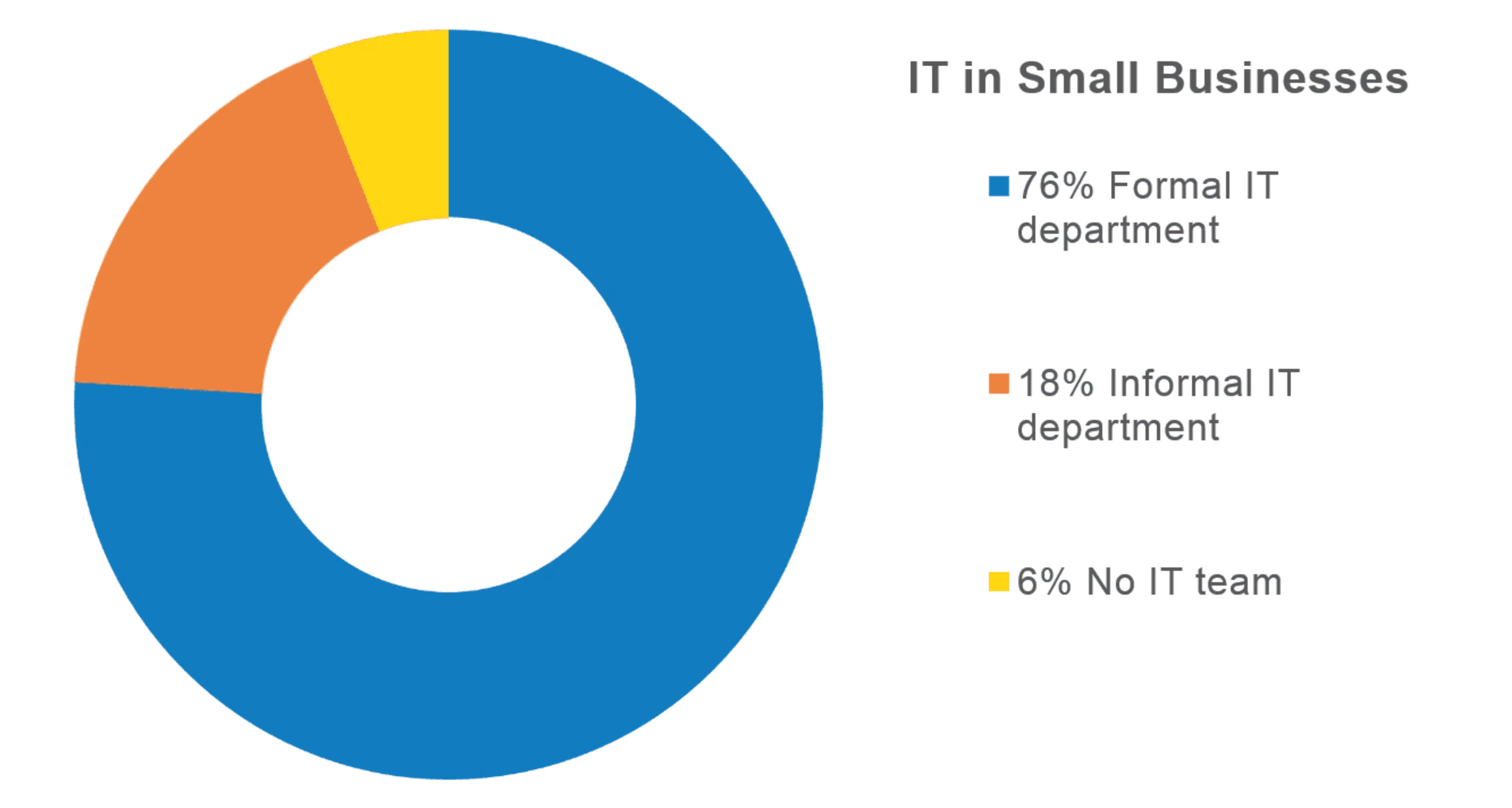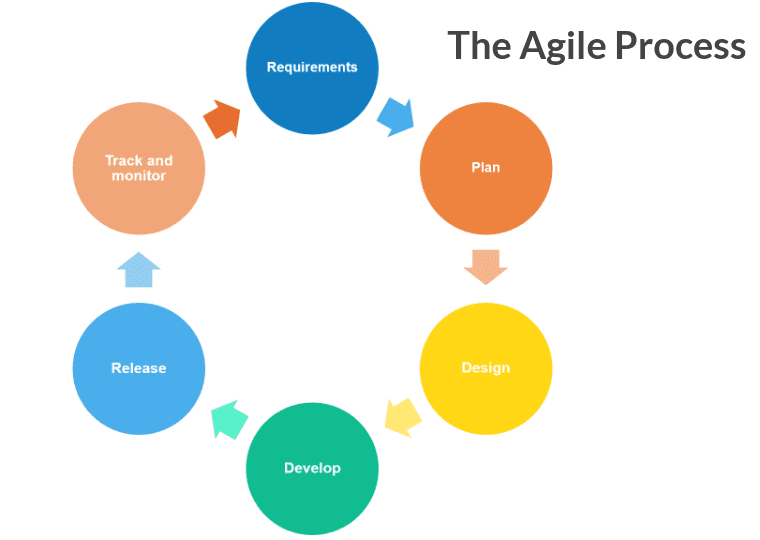You actually shouldn't have an IT team, at least according to the experts.
In 2008, Nasstar CEO Charles Black predicted in ComputerWeekly that no one would have an IT department after 2013. Gartner jumped on this idea as well, predicting in 2005 that one in 10 IT departments would be "dead by 2011."
These predictions aren't just stale leftovers from the early aughts. The IT department was also supposed to die out in 2017, as predicted by a tech professional ... in 2017.
But it's 2018, and I'm still here writing a blog about IT departments and you're still here reading it.

The IT team, as a concept, is actually alive and well. That likely has a lot to with the fact that, according to a recent Gartner survey1, 37% of both small and midsize businesses list advances in technology as one of the most significant external factors shaping their organization's business goals.
The effect of technology on the workplace isn't news, though. What is news is how workplaces are reorganizing in order to better take advantage of and maintain new tech.
Why is everyone predicting the death of IT departments?
So why does everyone keep swearing that we're about to send IT to the grave? Are we all so hubristic that we won't heed the prophets of 2013 until it's too late?
Probably not. My money is on the fact that a headline that includes "the IT department will die" is more likely to get clicked on because it's sensational.
Fun fact: I'm not here to pull you in with clickbait headlines. I'm here to give you information your small business can actually use.
And that information includes the fact that, far from killing off their IT teams, most small businesses have some form of an IT organization. According to the same Gartner survey I previously cited, 76% of small businesses have a formal IT department and 18% have an informal IT team. Only six percent have no IT department at all.
In the U.S., that means that only about 1.7 million small businesses (out of nearly 30 million) have no one managing IT ... or have just one very stressed out person managing everything tech-related.

So what are all of these sensationalist articles really trying to say when they predict that IT will soon take its last earthly breath?
Simple—the roles and structures of the IT team are changing, along with the technology they traditionally manage. So instead of holding funerals for your tech workers' jobs, let's do something that's actually productive and take a look at how you can start shifting your IT department's responsibilities now to get ahead of the game.
The small business advantage
In fact, small and midsize businesses, especially, have an advantage over their enterprise competitors to implement cutting-edge tech and business structures.
Aside from the overwhelming prevalence of workplace technology, another reason that enterprise IT departments haven't disappeared is because large organizations are often stuck with legacy systems that still have to be managed and adapted to modern usage.
Rather than focusing on innovative ways to align business and tech, large parts of their IT departments revolve around catching their tech up to their processes.
Because of this lag time in tech adaptation at the enterprise level, smaller businesses have a chance to get ahead.
Start focusing now on what your IT department structure should look like, in order to get ahead of the problem that enterprise-level teams have and not let your tech team stagnate as your business grows.
Read on to find out more about what the IT department of the future can—and should—look like, and how small businesses are better positioned than their larger competitors to implement these changes.
What does the IT department structure of the future look like?
The good news is that you can start implementing some of these changes to your IT department or team right away by taking a few small steps. Below, I've outlined three ways IT departments will look different in the future and how your IT team can take steps toward that modern IT department structure now.
1. IT will be better integrated into your business
You can find the classic pop culture representation of the antiquated IT department in the British comedy "IT Crowd."
If you've never seen the show, the IT department of a large corporation consists of three people, and their office is relegated to the basement. No one really knows what they do, nor do they seem to know what their business does. But they keep all the computers running, and that's what's important. Because of their isolation, they get up to quite a few shenanigans, which are the focus of the show.
None of that will fly in the IT department of the future. Although you should allow your employees to shenaniganize every now again. That's just common decency.

If your IT department is siloed, it's time to connect them with the rest of your business (via GIPHY)
Since technology permeates nearly every business process, the people who manage that tech should be well-versed in those business processes.
While you can still look to your IT team to fix the printer or add e-commerce functionality to your site, they shouldn't be limited to those types of tasks. You should also look to them for advice and innovative ideas regarding the way IT can help your business meet its goals.
Could decreasing your website load time increase your revenue? It's likely. Could using cloud technology help to ease some of your cybersecurity concerns? It's possible.
Members of your IT team should be aware of your business goals and be able to connect any tech innovations back to meeting or surpassing those business goals.
Just as your non-tech employees are becoming increasingly more tech-literate and figuring out how tools such as business software can improve their day-to-day lives, you should expect your tech employees to have a minimum level of business literacy.
What your small business can do now
This might be the easiest change to make since it really just involves changing your mindset about the purpose of your IT department. If you think of your tech workers mainly as your website managers or laptop fixers, start dispelling that idea. Your IT employees serve the business's needs just as much as sales or marketing does.
Make sure you're including at least one representative of IT in high-level business meetings so they can add a tech-conscious perspective to each discussion.
If you have open IT positions, hire applicants with an understanding of both IT and business. Or, at the very least, hire someone who demonstrates good communication skills who would excel at cross-departmental communication.
But the burden of communication shouldn't be all on IT. Train all your employees to develop soft skills for better communication and collaboration between departments and teams.
2. IT (and your whole business) should be more Agile
Communication skills are crucial to this next way that IT—and your whole organization—will have to adapt to the future of business: Agile is coming.
"Business Agile" is a trending methodology that emphasizes collaboration and flexibility in any business project.
Put simply, Agile allows your team to work on various parts of a project simultaneously, which differs from the more traditional method of waiting for one step to be done before moving on to the next. The diagram below shows the general iterative steps of the Agile methodology:

The Agile methodology allows teams to work quickly and collaborate effectively
Implementing Agile processes within your IT department and throughout your business at large could lead to quicker turnaround times on projects and more of the critical cross-department collaboration I mentioned earlier.
What your small business can do now
The good news is that your IT team, more than any of your other departments, is likely full of relative Agile experts, as Agile and Scrum (an Agile framework) started as a way to organize software development projects.
However, if you're not using Agile you should start learning about and following its methodology now.
To be clear, this shouldn't be limited to your tech team. "Business Agile" includes the whole business, so everyone should be learning how to follow its processes.
Bonus: getting everyone to use the same project management methodology can help encourage cross-team projects and make them run more smoothly.
3. IT will be more customer focused
Increased use of cloud and Software-as-a-Service technologies means IT doesn't have to focus as much on back-end development and architecture—another reason to take them out of the basement.
Instead, IT will be more customer focused, with an emphasis on increased knowledge of user experience (UX), user interfaces (UI), and design.

Gone are the days when IT can simply tell people to turn things off, then on again (via GIPHY)
UX, UI, and design will all involve some basic business knowledge (how customers interact with your site and what they're looking for when they're on it), as well as cross-team communication with your product, marketing, and sales departments—to name a few—to determine how to implement their best practices digitally.
What your small business can do now
If you haven't already done this, get your tech team in a room with sales, marketing, etc., to relay what these customer-facing departments are seeing from customers in terms of their wants and needs.
You could also have a randomly selected group of employees regularly test your site to get feedback on UX. There are also companies that provide user testing services if you don't want to add another task to your employees' to-do lists.
Whatever the feedback from your method of UX testing is, it will involve a focus on your customer, as well as collaboration between IT and other teams to create a product that meets everyone's needs and standards.
IT isn't going anywhere
The bottom line is that, until the zombie apocalypse happens and civilization as we know it falls apart entirely, advances in technology are likely to remain a top business concern.
And until we're all employing AI bots to manage our every thought, your small business will likely need someone around to make sure you're using tech to its full potential.
Don't get stuck with an outdated IT department structure. Take advantage of the flexibility you already have as a small business to modernize how your IT team works together and with the rest of your organization.
What are your experiences with small business IT? How does your IT team contribute to your business running smoothly? Do you have any predictions of your own about what IT department responsibilities we might see in the future as technology develops further? Let me know in the comments below.
Need more information?
A guide to teaching Agile to your tech team